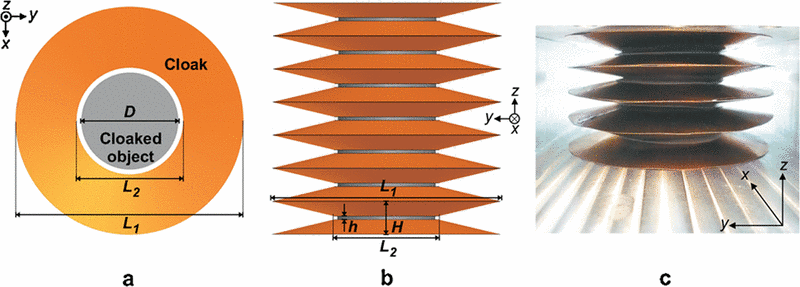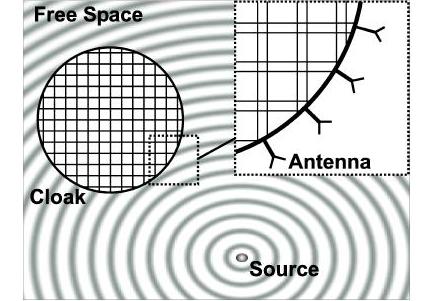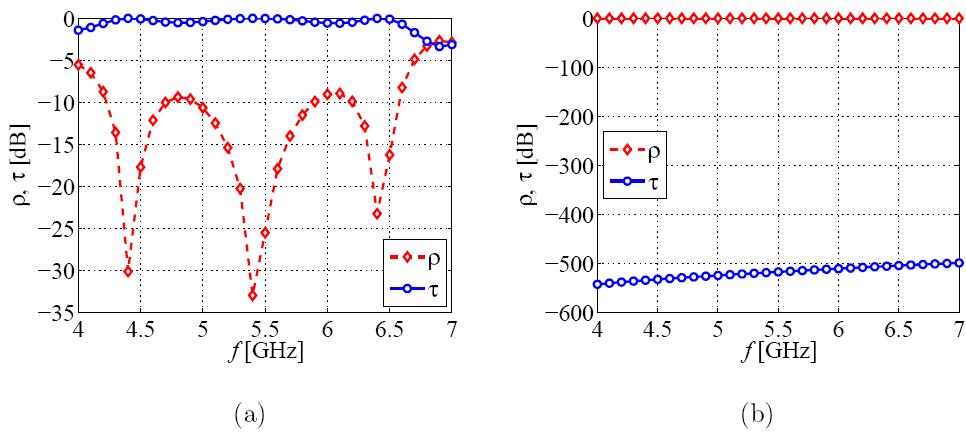
Cloaking from electromagnetic fields with transmission-line networks
Recently, a lot of effort has been devoted to creating materials or devices that can effectively cloak objects (e.g. dielectric or metallic cylinders or spheres) from the electromagnetic fields that exist in the medium that surrounds the object. See e.g. recent works by the groups of profs. John Pendry, David Smith, Nader Engheta, and Vladimir Shalaev. Cloak hides an arbitrary object (of a fitting size) from electromagnetic fields, meaning that removing the object with the cloak does not change electromagnetic fields outside the cloak volume. In other words, ideally cloaked objects do not scatter in any direction (do not create reflections, do not create shadows, and do not scatter in other directions). Technically speaking, this means that their total scattering cross section is zero for any direction of illumination and any polarization of the incident field. There is also a notion of invisible objects. An invisible object also does not scatter, but with that technology one cannot hide an arbitrary object inside.
Our recent overview of this field, inlcuding some historical aspects, can be found here. This lecture (as well as the lecture on the transmission-line cloak developed in our group, see below) was given at the European Doctoral School on Metamaterials (Rome, Italy, October 25, 2007), and, with some updates, at the European School of Antennas (Göteborg, Sweden, November 1, 2007). See also the review paper P. Alitalo and S. Tretyakov, Electromagnetic cloaking with metamaterials, Materials Today, vol. 12, no. 3, pp. 22-29, March 2009.
In this project we study an alternative method of cloaking in the microwave region. The method is based on using transmission-line networks that mimic the wave propagation in the surrounding medium, thus being left "undetected" by an incident electromagnetic wave. The evident drawback is that the objects that can be cloaked with this method have to be smaller than the period of the network, but this can be e.g. a two-dimensional or three-dimensional interconnected mesh of small objects, since the fields are confined in the transmission lines. Also, this cloak operates only for one polarization if the antennas work only for one polarization. See the figure below for the illustration of the idea.

See a preprint of our recent paper on this subject here (published paper: P. Alitalo, O. Luukkonen, L. Jylhä, J. Venermo, and S.A. Tretyakov, Transmission-line networks cloaking objects from electromagnetic fields, IEEE Trans. Antennas Propagation, vol. 56, no. 2, pp. 416-424, 2008). In this paper we consider loaded and unloaded transmission-line networks and the possibility of using such networks in cloaking applications. If the cloak (and the object that needs to be cloaked) are placed in free space, ideal wave propagation in an unloaded network is impossible to achieve with conventional materials. By loading the network with e.g. capacitive loads, the correct propagation constant can be achieved in a very narrow frequency band. Since the most currently available cloaking methods are limited to cloaking of time-harmonic fields only when placed in free space (a signal that is re-routed around the cloaked object would have to travel faster than light), the most promising feature of the cloak proposed here is the fact that for the unloaded network, the group velicity is equal to the phase velocity. Although they are both slightly different from those in free space, effective cloaking can be obtained also from signals. In the figure below, we present FDTD simulations of a reference object (left) and a cloak which can encompass the reference object (right). The cloak diameter is 128 mm and the center frequency of the incoming pulse is 1 GHz. In the figures the pulse has just passed the reference object and the cloak.

Naturally, one of the key issues in this approach is how to match a wave travelling in a homogeneous medium, such as free space, to a transmission-line network. We propose to do this with a "transition layer" that consists of sections of simple parallel-plate waveguides that are comparable in size with the network period. Below we demonstrate the feasibility of this method by considering reflection and transmission for a transversally infinite slab made of our cloak "material", i.e., 2-D transmission-line networks stacked on top of each other (in this case the network is designed to be matched with free space around 5 GHz). In the figure below, (a) is a simulation of the cloak slab with the cloaked reference object inside, and (b) is the simulation of the reference object only. The results are obtained with a commercial full-wave simulator. Here rho is the reflection coefficient, and tau is the transmission coefficient. We see that while the reference metal object reflects nearly all the power, the same object in our cloak looks transparent. For details on the structure, see the link to the preprint above.

Another way to realize broadband cloaks is to use conically shaped metal sheets, as is explained in this paper: S. Tretyakov, P. Alitalo, O. Luukkonen, and C. Simovski, Broadband electromagnetic cloaking of long cylindrical objects, Physical Review Letters, vol. 103, p. 103905, 2009 (see also popular article).
Main publications
- P. Alitalo and S. Tretyakov, Electromagnetic cloaking with metamaterials, Materials Today, vol. 12, no. 3, pp. 22-29, March 2009.
- S. Tretyakov, P. Alitalo, O. Luukkonen, and C. Simovski, Broadband electromagnetic cloaking of long cylindrical objects, Physical Review Letters, vol. 103, p. 103905, 2009
- P. Alitalo, O. Luukkonen, L. Jylhä, J. Venermo, and S.A. Tretyakov, Transmission-line networks cloaking objects from electromagnetic fields, IEEE Trans. Antennas Propagation, vol. 56, no. 2, pp. 416-424, 2008.